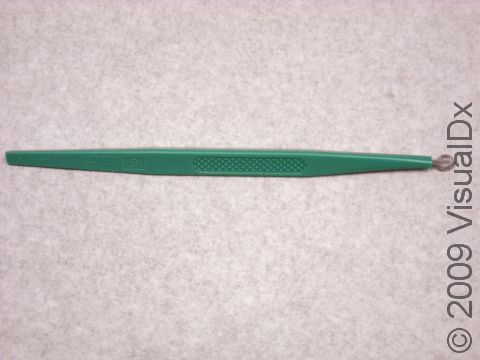Curettage
Curettage, in dermatology, is a surgical procedure that uses a curette, a small scooped-shaped instrument, to scrape off noncancerous skin growths and certain skin cancers such as:
- Basal cell carcinomas
- Viral warts and noncancerous lesions smaller than 1 cm
- Seborrheic keratoses
Who's At Risk?
- To increase the chance of skin cancer cure after biopsy.
- To eliminate irritating skin growths.
- To remove contagious lesions.
Signs & Symptoms
Curettage is easily and safely performed during a same-day office visit with no preparation necessary on the part of the patient.
At the time of the procedure, the area to be treated is cleaned with an alcohol wipe. Once locally anesthetized, the physician uses a rounded but sharp, spoon-like instrument to scrape the skin. An electrical hot metal tip is used to stop any minor bleeding. The tissue may be sent out for examination under a microscope to confirm the clinical diagnosis (eg, biopsy).
Self-Care Guidelines
Once the lesion is treated, a round defect in the surface of the skin will slowly heal into a visible scar. The wound will be dressed with a small non-adherent dressing using white petrolatum or antibacterial ointment to protect the wound as it heals.
The wound should not be washed for the first 24–48 hours to allow for initiation of proper healing. Thereafter, it can be cleansed with gentle soap and water. A Band-Aid® with white petrolatum or antibiotic ointment can be reapplied daily as needed.
Treatments
- Regular surgical excision
- Liquid nitrogen therapy
- Laser treatment
When to Seek Medical Care
Curettage is a well-tolerated and safe procedure. As with any other procedure, however, there is always a risk of infection developing at the site. Additionally, injuring nerves or vessels in the skin can occur in poorly selected sites where the skin is too thin to undergo curettage. If the curetting instrument reaches the level of the fat, the procedure will be halted. At that point, it might be best to switch procedures to a regular excision in order to close the wound with sutures.
Last modified on October 5th, 2022 at 7:15 pm

Not sure what to look for?
Try our new Rash and Skin Condition Finder
